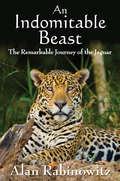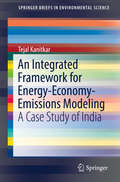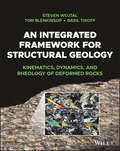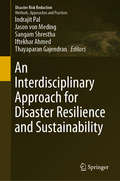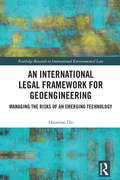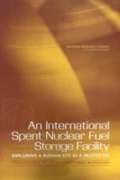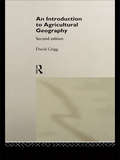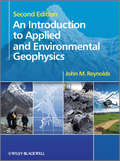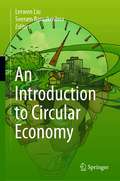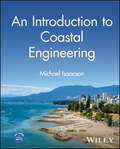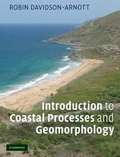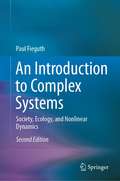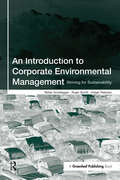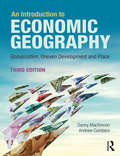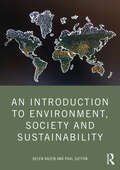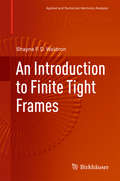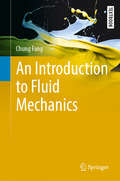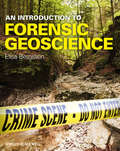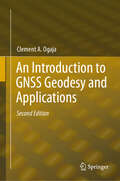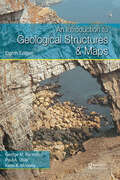- Table View
- List View
An Indomitable Beast: The Remarkable Journey of the Jaguar
by Alan RabinowitzThe jaguar is one of the most mysterious and least-known big cats of the world. The largest cat in the Americas, it has survived an onslaught of environmental and human threats partly because of an evolutionary history unique among wild felines, but also because of a power and indomitable spirit so strong, the jaguar has shaped indigenous cultures and the beliefs of early civilizations on two continents. In An Indomitable Beast: The Remarkable Journey of the Jaguar, big-cat expert Alan Rabinowitz shares his own personal journey to conserve a species that, despite its past resilience, is now on a slide toward extinction if something is not done to preserve the pathways it prowls through an ever-changing, ever-shifting landscape dominated by humans. Rabinowitz reveals how he learned from newly available genetic data that the jaguar was a single species connected genetically throughout its entire range from Mexico to Argentina, making it unique among all other large carnivores in the world. In a mix of personal discovery and scientific inquiry, he sweeps his readers deep into the realm of the jaguar, offering fascinating accounts from the field. Enhanced with maps, tables, and color plates, An Indomitable Beast brings important new research to life for scientists, anthropologists, and animal lovers alike. This book is not only about jaguars, but also about tenacity and survival. From the jaguar we can learn better strategies for saving other species and also how to save ourselves when faced with immediate and long-term catastrophic changes to our environment.
An Integrated Framework for Energy-Economy-Emissions Modeling: A Case Study of India (SpringerBriefs in Environmental Science)
by Tejal KanitkarThis book combines three different energy-economy-emissions modeling methodologies into one Integrated Modeling Framework (IMF) in an attempt to fill gaps in current modeling research as it applies to developing countries. Through the analysis of existing mathematical models, including large macro-economic models and technology-explicit energy models, the work proposes planning methodologies for developing countries that face challenges on their economy and infrastructure due to climate change. The three modeling methodologies discussed in the chapters are a decomposition analysis of trends in emissions intensity of GDP, linear programming techniques to determine optimum energy supply pathways given various resource and emissions constraints, and an input-output analysis to evaluate the impact of energy policies on income and equity. After a brief introduction to the history of the development of energy studies and the linkages between energy, economic, and environmental systems, the book delves into the component methodologies of the IMF and their intended outcomes. The decomposition analysis is intended to gauge the energy intensity of GDP and the structural composition of the economy to provide a basis on which scenarios are constructed in the following two methodologies. The linear programs are meant to develop a methodology to determine energy options under a variety of scenarios that capture the technical and economic characteristics of the power sector of developing countries. Lastly, the input-output analysis aims to build a methodology through which energy policy decisions can be understood and quantified to ensure the best possible impacts on developing economies and societies. Those who will be interested in this book include policy makers, academics, and students and professionals working on energy studies and energy-economy modeling.
An Integrated Framework for Structural Geology: Kinematics, Dynamics, and Rheology of Deformed Rocks
by Steven Wojtal Tom Blenkinsop Basil TikoffAN INTEGRATED FRAMEWORK FOR STRUCTURAL GEOLOGY A modern and practice-oriented approach to structural geology An Integrated Framework for Structural Geology: Kinematics, Dynamics, and Rheology of Deformed Rocks builds a framework for structural geology from geometrical description, kinematic analysis, dynamic evolution, and rheological investigation of deformed rocks. The unique approach taken by the book is to integrate these principles of continuum mechanics with the description of rock microstructures and inferences about deformation mechanisms. Field, theoretical and laboratory approaches to structural geology are all considered, including the application of rock mechanics experiments to nature. Readers will also find: Three case studies that illustrate how the framework can be applied to deformation at different levels in the crust and in an applied structural geology context Hundreds of detailed, two-color illustrations of exceptional clarity, as well as many microstructural and field photographs The quantitative basis of structural geology delivered through clear mathematics Written for advanced undergraduate and graduate students in geology, An Integrated Framework for Structural Geology will also earn a place in the libraries of practicing geologists with an interest in a one-stop resource on structural geology.
An Interdisciplinary Approach for Disaster Resilience and Sustainability (Disaster Risk Reduction)
by Sangam Shrestha Indrajit Pal Iftekhar Ahmed Jason Von Meding Thayaparan GajendranThis book includes selected papers presented at the international expert forum on “Mainstreaming Resilience and Disaster Risk Reduction in Education,” held at the Asian Institute of Technology, Thailand on 1–2 December 2017. The journey towards disaster risk reduction and resilience requires the participation of a wide array of stakeholders ranging from academics to policymakers, to disaster managers. Given the multifaceted and interdependent nature of disasters, disaster risk reduction and resilience require a multidisciplinary problem-solving approach and evidence-based techniques from the natural, social, engineering, and other relevant sciences.Traditionally, hazard and disaster-related studies have been dominated by the engineering and social science fields. In this regard, the main purpose of this book is to capture the multidisciplinary and multisectoral nature of disaster risk reduction, and to gather existing data, research, conceptual work, and practical cases regarding risk reduction and its ties to sustainable development under a single “umbrella.” Along with the sustainability aspect, the book also links disaster risk reduction with development, technology, governance, education, and climate change, and includes discussions on challenges, solutions, and best practices in the mainstreaming of disaster risk reduction.
An International Legal Framework for Geoengineering: Managing the Risks of an Emerging Technology (Routledge Research in International Environmental Law)
by Haomiao DuGeoengineering provides new possibilities for humans to deal with dangerous climate change and its effects but at the same time creates new risks to the planet. This book responds to the challenges geoengineering poses to International Law by identifying and developing the rules and principles that are aimed at controlling the risks to the environment and human health arising from geoengineering activities, without neglecting the contribution that geoengineering could make in preventing dangerous climate change and its impacts. It argues first that the employment of geoengineering should not cause significant environmental harm to the areas beyond the jurisdiction of the state of origin or the global commons, and the risk of causing such harm should be minimized or controlled. Second, the potential of geoengineering in contributing to preventing dangerous climate change should not be downplayed.
An International Spent Nuclear Fuel Storage Facility: EXPLORING A RUSSIAN SITE AS A PROTOTYPE
by National Research Council of the National AcademiesAs part of a long-standing collaboration on nuclear nonproliferation, the National Academy of Sciences and the Russian Academy of Sciences held a joint workshop in Moscow in 2003 on the scientific aspects of an international radioactive disposal site in Russia. The passage of Russian laws permitting the importation and storage of high-level radioactive material (primarily spent nuclear fuel from reactors) has engendered interest from a number of foreign governments, including the U.S., in exploring the possibility of transferring material to Russia on a temporary or permanent basis. The workshop focused on the environmental aspects of the general location and characteristics of a possible storage site, transportation to and within the site, containers for transportation and storage, inventory and accountability, audits and inspections, and handling technologies.
An Introduction to Agricultural Geography
by David GriggEmploying nearly half of the world's workforce, agriculture is clearly of great economic and social importance. An incredible variety of methods are used globally; the Western world has the latest scientific and industrial advancements at its disposal, yet in the Thrid World a living is made using tools that have hardly changed in two thousand years. An Introduction to Agricultural Geography provides an extensive guide through this diverse and increaslingly important geographical subject, aiming to show that a wide range of factors explain how agricultural practices differ from place to place. Dealing with the physical environment, economic behaviour and demands, institutional and social influences and the impact of farming upon the environment, the author has produced an important introductory text that is topical, incisive and ultimately essential to reach an understanding of the remarkable diversity of the world's major industry.
An Introduction to Applied and Environmental Geophysics
by John M. ReynoldsAn Introduction to Applied and Environmental Geophysics, 2nd Edition, describes the rapidly developing field of near-surface geophysics. The book covers a range of applications including mineral, hydrocarbon and groundwater exploration, and emphasises the use of geophysics in civil engineering and in environmental investigations. Following on from the international popularity of the first edition, this new, revised, and much expanded edition contains additional case histories, and descriptions of geophysical techniques not previously included in such textbooks.The level of mathematics and physics is deliberately kept to a minimum but is described qualitatively within the text. Relevant mathematical expressions are separated into boxes to supplement the text. The book is profusely illustrated with many figures, photographs and line drawings, many never previously published. Key source literature is provided in an extensive reference section; a list of web addresses for key organisations is also given in an appendix as a valuable additional resource.Covers new techniques such as Magnetic Resonance Sounding, Controlled- Source EM, shear-wave seismic refraction, and airborne gravity and EM techniquesNow includes radioactivity surveying and more discussions of down-hole geophysical methods; hydrographic and Sub-Bottom Profiling surveying; and UneXploded Ordnance detectionExpanded to include more forensic, archaeological, glaciological, agricultural and bio-geophysical applicationsIncludes more information on physio-chemical properties of geological, engineering and environmental materialsTakes a fully global approachCompanion website with additional resources available at www.wiley.com/go/reynolds/introduction2eAccessible core textbook for undergraduates as well as an ideal reference for industry professionalsThe second edition is ideal for students wanting a broad introduction to the subject and is also designed for practising civil and geotechnical engineers, geologists, archaeologists and environmental scientists who need an overview of modern geophysical methods relevant to their discipline. While the first edition was the first textbook to provide such a comprehensive coverage of environmental geophysics, the second edition is even more far ranging in terms of techniques, applications and case histories.
An Introduction to Applied and Environmental Geophysics
by John M. ReynoldsAn Introduction to Applied and Environmental Geophysics, 2nd Edition, describes the rapidly developing field of near-surface geophysics. The book covers a range of applications including mineral, hydrocarbon and groundwater exploration, and emphasises the use of geophysics in civil engineering and in environmental investigations. Following on from the international popularity of the first edition, this new, revised, and much expanded edition contains additional case histories, and descriptions of geophysical techniques not previously included in such textbooks. The level of mathematics and physics is deliberately kept to a minimum but is described qualitatively within the text. Relevant mathematical expressions are separated into boxes to supplement the text. The book is profusely illustrated with many figures, photographs and line drawings, many never previously published. Key source literature is provided in an extensive reference section; a list of web addresses for key organisations is also given in an appendix as a valuable additional resource. Covers new techniques such as Magnetic Resonance Sounding, Controlled- Source EM, shear-wave seismic refraction, and airborne gravity and EM techniques Now includes radioactivity surveying and more discussions of down-hole geophysical methods; hydrographic and Sub-Bottom Profiling surveying; and UneXploded Ordnance detection Expanded to include more forensic, archaeological, glaciological, agricultural and bio-geophysical applications Includes more information on physio-chemical properties of geological, engineering and environmental materials Takes a fully global approach Companion website with additional resources available at www.wiley.com/go/reynolds/introduction2e Accessible core textbook for undergraduates as well as an ideal reference for industry professionals The second edition is ideal for students wanting a broad introduction to the subject and is also designed for practising civil and geotechnical engineers, geologists, archaeologists and environmental scientists who need an overview of modern geophysical methods relevant to their discipline. While the first edition was the first textbook to provide such a comprehensive coverage of environmental geophysics, the second edition is even more far ranging in terms of techniques, applications and case histories.
An Introduction to Atmospheric Physics
by David G. AndrewsAn Introduction to Atmospheric Physics presents a broad coverage of atmospheric physics, including atmospheric thermodynamics, radiative transfer, atmospheric fluid dynamics and elementary atmospheric chemistry. Armed with an understanding of these topics, the interested student will be able to grasp the essential physics behind issues of current concern, such as the enhanced greenhouse effect and associated questions of climate change, and the Antarctic ozone hole and global ozone depletion, as well as more familiar processes such as the formation of raindrops and the development of weather systems. This book is intended as an introductory text for intermediate to advanced undergraduates studying atmospheric physics as part of physics, meteorology or environmental science courses. It will also be useful for graduate students studying atmospheric physics for the first time and for students of applied mathematics, physical chemistry and engineering who have an interest in the atmosphere.
An Introduction to Atmospheric Thermodynamics
by Anastasios A. TsonisThis is a self-contained, concise, rigorous book introducing the reader to the basics of atmospheric thermodynamics, and the author is a highly respected researcher in this field. This new edition has been brought completely up to date and reorganized to improve the quality and flow of the material. Each chapter contains worked examples and student exercises, making this an ideal text for short undergraduate courses taken as part of an atmospheric science, meteorology, physics or natural science program. Solutions available to lecturers.
An Introduction to Circular Economy
by Seeram Ramakrishna Lerwen LiuThis book is purposefully styled as an introductory textbook on circular economy (CE) for the benefit of educators and students of universities. It provides comprehensive knowledge exemplified by practices from policy, education, R&D, innovation, design, production, waste management, business and financing around the world. The book covers sectors such as agriculture/food, packaging materials, build environment, textile, energy, and mobility to inspire the growth of circular business transformation. It aims to stimulate action among different stakeholders to drive CE transformation. It elaborates critical driving forces of CE including digital technologies; restorative innovations; business opportunities & sustainable business model; financing instruments, regulation & assessment and experiential education programs. It connects a CE transformation for reaching the SDGs2030 and highlights youth leadership and entrepreneurship at all levels in driving the sustainability transformation.
An Introduction to Coastal Engineering
by Michael IsaacsonUnderstand and respond to a changing coastline with this comprehensive reference Coastal engineering concerns society’s interactions with coastlines and relates, for example, to coastal flooding, beach erosion, seawalls and breakwaters, and the design of marinas. As climate change drives sea level rise, coastal engineering is critical in responding to increased coastal flooding and receding shorelines. The need to develop coastal infrastructure while minimizing environmental impacts makes this a vital field. An Introduction to Coastal Engineering offers a comprehensive overview of this subject, designed to bridge existing gaps in the general civil engineering literature. Covering all major aspects of coastal engineering, including ocean wave behaviour, structures, sediments, mixing processes, and modelling, the book emphasizes practical solutions and applications for students and practicing engineers alike. Thorough and rigorous, yet highly readable, the book is a must-own tool for developing solutions towards a sustainable coastal future. An Introduction to Coastal Engineering readers will also find: Pertinent descriptions of wave theories, wave transformations, and random wavesDetailed discussion of practical solutions, recent advancements in the field, and up-to-date data sourcesWorked-through examples and end-of-chapter problems with some written assignmentsA spreadsheet appendix containing a set of reference solutions An Introduction to Coastal Engineering is ideal for students in upper-level undergraduate and graduate courses in coastal engineering, practicing coastal engineers, and other engineers engaged in coastal flood protection, waterfront development projects, and the minimization of environmental impacts along shorelines.
An Introduction to Coastal Processes and Geomorphology
by Robin Davidson-ArnottWritten for undergraduate students studying coastal geomorphology, this is the complete guide to the processes at work on our coastlines and the features we see in coastal systems across the world. Accessible to students from a range of disciplines, the quantitative approach of this book helps to build a solid understanding of wave and current processes that shape coastlines. The resulting processes of erosion, transport and deposition and the features they create are clearly explained, with over 400 illustrations and photographs. From sandy beaches to coral reefs, the major coastal features are related to contemporary processes and to sea-level changes over the past 25,000 years. Key equations describing or predicting measurements from instruments used to map these processes are all presented in this wide-ranging overview. Davidson-Arnott completes this teaching package with online material that brings the subject to life, including videos of coastal processes and virtual field trips.
An Introduction to Complex Systems: Society, Ecology, and Nonlinear Dynamics
by Paul FieguthComplex Systems lie at the heart of a variety of large-scale phenomena of great significance - global warming, ice ages, water, poverty, pandemics - and this text uses these case studies as motivations and contexts to explore complex systems and related topics of nonlinear dynamics and power-law statistics. Although detailed mathematical descriptions of these topics can be challenging, the consequences of a system being nonlinear, power-law, or complex are in fact quite accessible. This book blends a tutorial approach to the mathematical aspects of complex systems together with a complementary narrative on the global/ecological/societal implications of such systems. Nearly all engineering undergraduate courses focus on mathematics and systems which are small scale, linear, and Gaussian. Unfortunately there is not a single large-scale ecological or social phenomenon that is scalar, linear, and Gaussian. This book offers insights to better understand the large-scale problems facing the world and to realize that these cannot be solved by a single, narrow academic field or perspective. Instead, the book seeks to emphasize understanding, concepts, and ideas, in a way that is mathematically rigorous, so that the concepts do not feel vague, but not so technical that the mathematics get in the way. The book is intended for students in technical domains such as engineering, computer science, physics, mathematics, and environmental studies. This second edition adds nine new examples, over 30 additional problems, 50 additional figures, and three new chapters offering a detailed study of system decoupling, extensive solutions to chapter problems, and a timely discussion on the complex systems challenges associated with COVID-19 and pandemics in general.
An Introduction to Corporate Environmental Management: Striving for Sustainability
by Stefan Schaltegger Roger Burritt Holger PetersenThis book is designed to meet the urgent need for a comprehensive and definitive introduction and teaching text on corporate environmental management. It aims to become the standard textbook for courses examining how business can take the environment into account while also providing an accessible and thorough overview of this increasingly multidisciplinary subject for practitioners.Written by the internationally acknowledged experts Stefan Schaltegger and Roger Burritt (authors of the highly influential Contemporary Environmental Accounting) along with Holger Petersen, the book invites the reader to join in an exploration of the ways in which companies can engage in environmental management and why such engagement can be profitable for business. The reader is invited to: examine whether the contents reflect their own experience, takes their experience further, or opposes their own views; note which of the ideas presented are especially important, add to those ideas, or encourage a reaction (positive or negative); answer questions creatively (based on their own perspective of the issues); encourage themselves to be inspired by questions, which can be investigated further through other written sources of information, such as books you will be guided to through the bibliography, the Internet or the general media; and think about and plan the ways in which the knowledge provided can be implemented in your own situation.The book is organised into four main sections. First, the fundamental ideas and linkages behind business management, the environment and sustainable development are briefly but clearly sketched. The second part of the book outlines the criteria against which environmentally oriented business management can be assessed and the fields of action in which success can be achieved. The third part presents a discussion and examples of strategies for environmental management, which are linked, in the fourth part, to the essential tools of environmental management, especially green marketing, environmental accounting and eco-control.The book is full of case studies and examples related to the main contents of each chapter and each chapter provides a number of questions for the student or reader to address.An Introduction to Corporate Environmental Management is both a textbook and a sourcebook. The reader can either work through the material in a structured way or dip into the content and follow up on specific areas of interest. The materials are designed to be used for understanding and reference, rather than to be learned by heart. The primary aim is for the reader to obtain a practical understanding of the relationship between management and environmental issues which can be applied in day-to-day situations-whether as part of a student's wider view of management or within the practitioner's real-world situation. It will be essential reading for many years to come.
An Introduction to Dynamic Meteorology
by James R. HoltonThis revised text presents a cogent explanation of the fundamentals of meteorology, and explains storm dynamics for weather-oriented meteorologists. It discusses climate dynamics and the implications posed for global change. Formulas have been removed.
An Introduction to Economic Geography: Globalisation, Uneven Development and Place
by Andrew Cumbers Danny MacKinnonIn the context of great economic turmoil and uncertainty, the emergent conflict between continued globalisation and growing economic nationalism means that a geographical economic perspective has never been so important. An Introduction to Economic Geography guides students through the key debates of this vibrant area, exploring the range of ideas and approaches that invigorate the wider discipline. This third edition includes new chapters on finance, cities and the digital economy, consumption and the environment. Underpinned by the themes of globalisation, uneven development and place, the text conveys the diversity of contemporary economic geography and explores the social and spatial effects of global economic restructuring. It combines a critical geographical perspective on the changing economic landscape with an appreciation of contemporary themes such as neoliberalism, financialisation, innovation and the growth of new technologies. An Introduction to Economic Geography is an essential textbook for undergraduate students taking courses in Economic Geography, Globalisation Studies and more broadly in Human Geography. It will also be of much interest to those in Planning, Business and Management Studies and Economics.
An Introduction to Energy Economics and Policy
by Massimo Filippini Suchita SrinivasanEnergy economics and policy are at the heart of current debates regarding climate change and the switch from fossil fuels to renewable forms of energy. They are also crucial in dealing with energy supply and security issues caused by global shocks such as the war in Ukraine. An Introduction to Energy Economics and Policy outlines pressing issues concerning current global energy systems, particularly energy production and use. It presents economic frameworks for valuating policy goals and for understanding the major energy and climate challenges faced by industrialized and developing countries. Integrating insights from behavioural economics into the standard neoclassical approach, particularly the role of behavioural anomalies, this book offers a novel introduction to energy economics and policy and provides a fresh perspective on real-world issues in energy and climate. This title is also available as open access on Cambridge Core.
An Introduction to Environment, Society and Sustainability
by Paul Sutton Helen HazenThis timely and innovative book delves into the complex interplay of human activities and natural limits in generating today’s sustainability challenges. By contrasting the pressures of growing populations with ecological footprints associated with consumption, the volume navigates the contested terrain where human societies generate environmental impacts.Adorned with illustrative figures, examples and case studies throughout, this book presents insightful analysis of ecological, economic, technological, and social justice responses to the challenges faced by human civilization, including land degradation, climate change, pollution, and overexploitation of natural resources. Many of these issues are wicked problems, characterized by incomplete information, multiple stakeholders, and contested approaches to addressing them. In simple terms, sustainability issues are an interplay between population growth and rising consumption, which are placing impossible demands on finite resources. Potential solutions to the crisis are split between green growth approaches that emphasize technology and institutional capacity to guide economic growth in more sustainable ways, and degrowth approaches that call for a fundamental rethinking of the way we structure society and generate value. This book emerged from a student seminar where undergraduate and graduate students highlighted sustainability topics of concern, helped consider their framing, and then assisted with co-writing several of the chapters. The volume encourages readers to consider structural questions that underpin sustainability dilemmas, and begins with four theoretical frameworks for understanding sustainability issues: ideas from the natural sciences, the population/consumption debate, economic frameworks, and ethical approaches. It then uses a systems approach to apply these theoretical ideas to complex global systems such as the atmosphere, oceans, and agriculture.This volume will be of pivotal interest to students, scholars and academics in the fields of environmental studies, environment and society, human geography and environmental geography, as well as those with an interest in these areas more generally.
An Introduction to Finite Tight Frames
by Shayne F. WaldronThis textbook is an introduction to the theory and applications of finite tight frames, an area that has developed rapidly in the last decade. Stimulating much of this growth are the applications of finite frames to diverse fields such as signal processing, quantum information theory, multivariate orthogonal polynomials, and remote sensing. Featuring exercises and MATLAB examples in each chapter, the book is well suited as a textbook for a graduate course or seminar involving finite frames. The self-contained, user-friendly presentation also makes the work useful as a self-study resource or reference for graduate students, instructors, researchers, and practitioners in pure and applied mathematics, engineering, mathematical physics, and signal processing.
An Introduction to Fluid Mechanics (Springer Textbooks in Earth Sciences, Geography and Environment)
by Chung FangThis textbook provides a concise introduction to the mathematical theory of fluid motion with the underlying physics. Different branches of fluid mechanics are developed from general to specific topics. At the end of each chapter carefully designed problems are assigned as homework, for which selected fully worked-out solutions are provided. This book can be used for self-study, as well as in conjunction with a course in fluid mechanics.
An Introduction to Forensic Geoscience
by Elisa BergslienAn Introduction to Forensic Geoscience provides fundamental training in geoscience as developed through the lens of its forensic applications. It incorporates a range of topics including geophysical methods of grave detection, the mineralogy of art, identification of microfossils, and comparison of soil trace evidence samples. Each topic is introduced using core concepts that are developed with increasing complexity in order to give readers an understanding of the underlying scientific principles involved and a taste of the wide range of possible forensic uses. A variety of detailed reference tables have been compiled for the text and each chapter contains lists of references to applicable textbooks and journal articles. Examples of real criminal cases are also presented in each chapter to make the connections between theory and real world application. The goal of this book is to give readers a familiarity with the wide range of ways in which geoscience principles and geological materials can be utilized forensically. Additional resources for this book can be found at: http://www.wiley.com/go/bergslien/forensicgeoscience.
An Introduction to GNSS Geodesy and Applications
by Clement A. OgajaThis volume is the second edition to 2022’s Introduction to GNSS Geodesy: Foundations of Precise Positioning Using Global Navigation Satellite Systems. It serves as an important reference to GNSS beginners as well as seasoned enthusiasts. In this updated edition, author Clement Ogaja focuses on fundamentals and contents that will remain unaffected by rapid changes and data exchange formats, ensuring that the book will remain up to date for years. The book consists of five chapters. The first covers basic concepts of parameter estimation in GNSS Geodesy. From there, Chapter 2 discusses reference systems in GNSS Geodesy. Chapter 3 moves on to observation models, errors, and biases, and Chapter 4, which is completely new to this second edition, details GNSS data processing workflow and strategies. The book concludes with an applied chapter that details concrete uses of GNSS Geodesy. New appendices that will be especially useful to seasoned users are also featured.
An Introduction to Geological Structures and Maps, Eighth Edition
by George M Bennison Paul A Olver Keith A MoseleyAn Introduction to Geological Structures and Maps is a concise and accessible textbook providing simple structural terminology and map problems which introduce geological structures. It is a perfect introduction to mapping for students of geology, engineering geology and civil engineering.Each topic is explained and illustrated by figures, and exercises follow on successive maps. If students are unable to complete an exercise, they can read on to obtain more specific instructions on how theory may be used to solve the problem. An appendix at the end of the book provides the solutions.This new, eighth edition contains simplified introductory matter to make the subject as easy to grasp as possible. Colour photographs illustrating geological structures bring the subject to life and a new map from the British Geological Survey illustrates a real area. There is more on outcrop patterns, which will help students to think in 3D, and on structures and the relationship of topography to geological structure. Cliff sections have been added to reinforce the concept of apparent dip. The section on planetary geology has been more closely tied to igneous geology to aid understanding of the connection between the two. Finally, a new map on economic geology has been added for the benefit of engineering students.A geological glossary helps students to understand and memorise key terms and a new, colourful, text design enlivens the appearance of this popular book.
